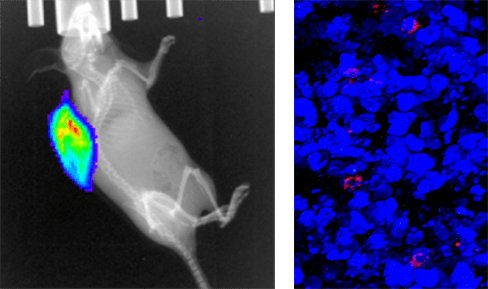
MOLECULAR INSIGHT

We have developed an original Treg Molecular Signature (TregSign kit) which allows, in a single assay, a complete transcriptomic study of Tregs.
The signature allows us to determine the impact of a molecule on Tregs and their microenvironment
Phenotype
Suppressive function
Expansion
Induction
Adhesion
Activation state
Migration
Infiltration
Plasticity
Preclinical Potential applications
In vitro and in vivo
- Lead identification & screening
- Safety & Immunotoxicity
- Assessment of new therapeutic candidates regarding Treg response
- Proof of Concept
Clinical potential applications
Diagnostics & Therapeutics
- Patient immuno-monitoring
- Patient stratification for better treatment choice
- Diagnostic and prognostic value

CELLULAR INSIGHT
PBMC/Treg Supression Assay

We offer a wide range of methods to comprehensively assess the efficacy and safety of your compound of interest on Treg Biology. Immunomonitoring and Immunophenotyping of Tregs by :
Suppressive Function Assays
Recruitment Analysis
Secretion Profile
Cell Death & Viability Assay
Tumour Infiltration Analysis

ANIMAL INSIGHT
In vivo assessment of a compound efficacy and safety can be carried out on a human cancer model designed for you (Syngeneic, PDX-Like models…).
PDX-Like model: Humanized SCID mice allow a complete monitoring of disease advancement, organ infiltration, toxicity etc.

REFERENCES
Bibliography of Immune insighT and its founding members:
IST: Immune insighT
Treg Signature (TregSign Kit) POC
Fresh PBMCs
- Immune Regulation After High Dose Hypofractionated Radiotherapy Leads to Complete Clinical Response in A Renal Adenocarcinoma Patient Case. Biomed J Sci & Tech Res, 2019
- Beta-2 Microglobulin And Ubiquitin C Identified as Two Robust Housekeeping Genes for RNA Expression Normalization in Real Time PCR on Human Leukocytes and Regulatory T Cells. Biomed J Sci & Tech Res, 2020
Frozen PBMCs
- Analysis of gene transcription in sera during chronic hepatitis C infection. . J Med Virol, 2009
- CD49b, a major marker of regulatory T-cells type 1, predicts the response to antiviral therapy of recurrent hepatitis C after liver transplantation. Biomed Res Int. , 2014
- Early high levels of regulatory T cells and T helper 1 may predict the progression of recurrent hepatitis C after liver transplantation. Clin Res Hepatol Gastroenterol, 2019
Patient serum
- Analysis of gene transcription in sera during chronic hepatitis C infection. J Med Virol, 2009
- Increased expression of regulatory Tr1 cells in recurrent hepatitis C after liver transplantation Am J Transplant. , 2009
- CD49b, a major marker of regulatory T-cells type 1, predicts the response to antiviral therapy of recurrent hepatitis C after liver transplantation. Biomed Res Int. ,2014
- Epstein-Barr virus infection induces an increase of T regulatory type 1 cells in Hodgkin lymphoma patients. 2014 Br J Haematol , 2014
Tumor tissue sample
- Epstein-Barr virus infection induces an increase of T regulatory type 1 cells in Hodgkin lymphoma patients. Br J Haematol, 2014
Other tissue sample
- Liver Biopsies: Analysis of gene transcription in sera during chronic hepatitis C infection. J Med Virol, 2009
- Liver Biopsies: Increased expression of regulatory Tr1 cells in recurrent hepatitis C after liver transplantation Am J Transplant. , 2009
- Frozen Liver Biopsies: Overexpression of Regulatory T Cells Type 1 (Tr1) Specific Markers in a Patient with HCV-Induced Hepatocellular Carcinoma. ISRN Hepatol., 2013
- Fresh Liver Biopsies: CD49b, a major marker of regulatory T-cells type 1, predicts the response to antiviral therapy of recurrent hepatitis C after liver transplantation. Biomed Res Int., 2014
Clinical trial immunomonitoring
- Immune Regulation After High Dose Hypofractionated Radiotherapy Leads to Complete Clinical Response in A Renal Adenocarcinoma Patient Case – Biomedical Journal of Scientific & Technical Research, 2019
- INtraoperative photoDYnamic Therapy for GliOblastomas (INDYGO): study protocol for a phase I clinical trial: Intraoperative Photodynamic Therapy for GBM. Archives ouvetes.fr, 2019
- Combination of High Dose Hypofractionated Radiotherapy with Anti-PD1 Single Dose Immunotherapy Leads to a Th1 Immune Activation Resulting in a Complete Clinical Response in a Melanoma Patient. International Journal of Molecular Sciences. 2020
Humanized PDX-Like model POC
- Activation of a Helper and Not Regulatory Human CD4+ T Cell Response by Oncolytic H-1 Parvovirus. PLoS One., 2012
- Effect of nasopharyngeal carcinoma-derived exosomes on human regulatory T cells. J Natl Cancer Inst., 2014
- Specific folic-acid targeted photosensitizers. The first step toward intraperitoneal photodynamic therapy for epithelial ovarian cancer. Gynecol Obstet Fertil Senol. 2017
- An Efficient Photodynamic Therapy Treatment for Human Pancreatic Adenocarcinoma. J Clin Med. 2020 Jan; 9(1): 192., 2020
Review
